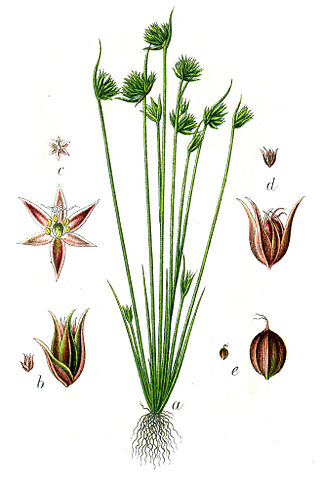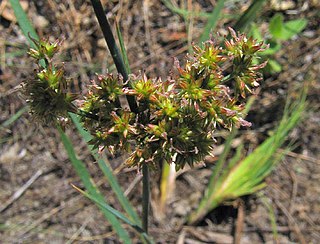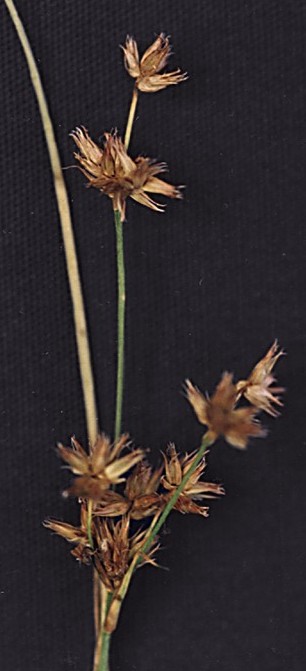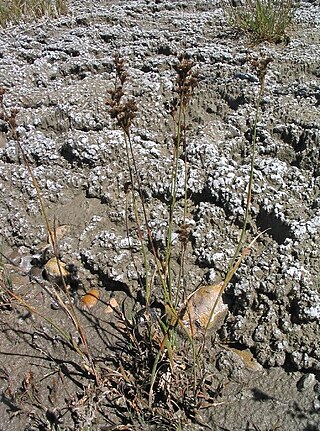
Juncaceae is a family of flowering plants, commonly known as the rush family. It consists of 8 genera and about 464 known species of slow-growing, rhizomatous, herbaceous monocotyledonous plants that may superficially resemble grasses and sedges. They often grow on infertile soils in a wide range of moisture conditions. The best-known and largest genus is Juncus. Most of the Juncus species grow exclusively in wetland habitats. A few rushes, such as Juncus bufonius are annuals, but most are perennials.

Juncus is a genus of monocotyledonous flowering plants, commonly known as rushes. It is the largest genus in the family Juncaceae, containing around 300 species.

Juncus effusus is a perennial herbaceous flowering plant species in the rush family Juncaceae, with the common names common rush or soft rush. In North America, the common name soft rush also refers to Juncus interior.

Juncus bufonius, known commonly as toad rush, is a widespread flowering plant species complex in the rush family Juncaceae.

Juncus acutus, the spiny rush, sharp rush or sharp-pointed rush, is a flowering plant in the monocot family Juncaceae. It is native to the Americas, Northern and Southern Africa, Western and Southern Europe and West Asia, and is found in a variety of wet habitats, such as bogs, fens, meadows, and salt marshes, and along the edges of ponds and lakes.

Juncus articulatus is a flowering plant species in the rush family Juncaceae. It is known by the common name jointleaf rush or jointed rush, which can also refer to J. kraussii from Australia. It is native to Eurasia, Canada, Greenland and much of the United States. It grows in moist areas, such as wet sand, and thrives in calcareous soils. J. articulatus was found to be more sensitive to drought and salt stress than its congeners J. acutus and J. maritimus. It is a perennial herb producing mainly erect stems from a short rhizome. The stem may root at nodes, and it generally has one or more flattened hollow cylindrical leaves up to 10 centimeters long. Transverse internal partitions or joints may be seen or felt in the leaf of the plant.

Juncus capitatus is a species of rush known by the common names dwarf rush and leafybract dwarf rush. It is native to Europe, Asia and North Africa. It is also an introduced species in parts of North America such as California and the Gulf Coast. It grows in moist areas, such as wet sand, vernal pools, and ditches.

Juncus patens is a species of rush, known by the common names spreading rush and California grey rush.

Juncus dubius is a species of rush known by the common name wrinkled rush. It is endemic to California, in the California Coast Ranges, Transverse Ranges, and southern Sierra Nevada. It is a common member of the flora in many wet areas, such as marshes and riverbanks.

Juncus xiphioides is a species of rush known by the common name irisleaf rush.
Juncus leiospermus is an uncommon species of rush known by the common name Red Bluff dwarf rush. It is endemic to California, where it is known only from the Central Valley and adjacent Sierra Nevada foothills to the east.

Juncus nodosus is a species of rush known by the common name knotted rush. It is native to much of North America from northern Canada to central Mexico, where it grows in wet places from freshwater to salt marsh habitat. This is a rhizomatous perennial herb producing slender, smooth stems up to about 60 centimeters tall. The inflorescence is a series of spherical clusters of flowers. Each flower has green or brown pointed segments each a few millimeters long and tapering to a point.

Juncus saximontanus is a species of rush known by the common name Rocky Mountain rush. It is native to much of western North America from Alaska to central Mexico, where it grows in wet habitat, often in mountainous areas, such as bogs and moist meadows.
Juncus triformis is an uncommon species of rush known by the common names Yosemite dwarf rush and long-styled dwarf rush.
Juncus digitatus is a rare species of rush known by the common name finger rush. It is endemic to Shasta County, California, where it is known from only two occurrences near Shingletown. It occurs in spring-moist habitat such as vernal pools in sunny locations in the foothills of the southernmost Cascade Range. The plant was first collected in 1991 and described to science as a new species in 2008.

Juncus acutiflorus, also called sharp-flowered rush, is a rush or a grassy flowering plant in the family Juncaceae. As the name suggests, the plant has notable sharp-looking flowers, flowering between July and September.

Juncus marginatus is a species of flowering plant, it is a type of rush with the common names of margined rush and grass-leaf rush.













